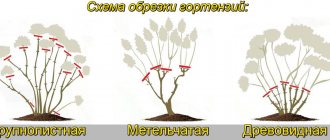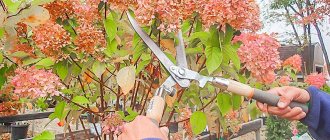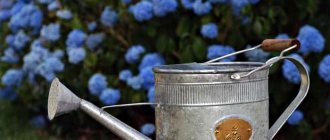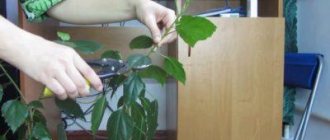A luxurious, truly royal look is given to hydrangea by its lush inflorescences of pastel colors. She delights her admirers from May to October, lavishing aroma and decorating garden plots with the delicate colors of flowers. To achieve the appearance of such beauty, you should put some effort into growing this plant and constantly caring for it. The abundant flowering of bushes largely depends on a procedure such as pruning. Different types of plants require special rules to be followed during the process. Their exact observance will respond with gratitude in the form of abundant flowering of the bushes.
Spring pruning
First you need to determine the type of plant, because this determines what kind of pruning is needed. Plants are divided into 2 groups, flowering on shoots:
- Last year (large-leaved);
- Current year (tree-like, paniculate species).
Lush blooming of beautiful hydrangea
How to prune hydrangea in spring depends on the type of plant.
Pruning of hydrangeas of the first group in the spring should be done carefully, removing only dried inflorescences and weak shoots damaged in winter. The standard one is inappropriate here, it will deprive the bushes of flowering.
Having chosen the appropriate time: day and month, they begin to work. The step-by-step process occurs in the following order:
- Thin out the bush (tree).
- Remove weak branches, retreating from the surface of the ground to the width of your palm.
- The shoots located inside the bush are cut out.
- Branches damaged by frost are cut off at the level of “living” wood.
After finishing the work, the bush is fixed to the support and tied up.
Standard formation of hydrangea
bhg.com
Paniculate hydrangea can be given a standard form. To do this, all the shoots of the young bush are cut out, leaving the most powerful one. It is driven out to 70-100 cm, regularly removing all side shoots and shoots. When the height is reached using regular pruning, a spherical crown is formed. This tree is very impressive, but requires tying the trunk to a strong support.
The shoots of paniculate hydrangea are very fragile, and the inflorescences form a huge cap and can break off without a garter. In general, fragility of shoots is characteristic not only of standard trees, but also of bushes, especially overgrown and unpruned ones.
Types of pruning
Caring for hydrangea in spring - how to properly replant hydrangea
Proper pruning includes several types:
- Standard haircut that is done every year. You need to trim the bush to create a strong plant with abundant flowering.
- Formative - to give the plant the required configuration and optimal arrangement of skeletal branches.
- Sanitary – removal of damaged, old shoots, dried inflorescences.
- Rejuvenating – carried out on heavily damaged and old bushes.
Dates
How to water garden hydrangea correctly
They often use spring pruning, when the snow has not yet melted. The procedure begins with the swelling of the growth buds, since they determine the choice of branches that need to be trimmed. Usually this is the month of March or early April. In addition, specific weather conditions must be taken into account. Even if the buds are swollen, the event should be postponed if cold weather returns. But you can’t put it off for a long time, because the plant must have time to develop growths that will bloom within its standard time frame.
The duration of this operation also depends on the type of plant. Tree hydrangea develops more slowly than paniculata; it will take more time to form shoots, so work should be carried out earlier (March). For paniculata, late pruning (in April) is suitable. For large-leaved flowers, you need to do it in early spring, but keep in mind that it blooms on last year’s shoots.
When can you prune tree hydrangea?
Compared to paniculata and some other species, tree hydrangea requires earlier pruning in the spring. It grows more slowly, so if you miss the deadline, the plant will noticeably lag behind in development, which can adversely affect its health.
The optimal time is considered to be March, when the snow has completely melted and the daytime temperature is above zero. Specific dates depend on the climatic conditions of the region:
- in the south you can start as early as the end of February;
- in the Moscow region and the middle zone - in the second ten days of March;
- in the Urals, Siberia, and the Far East - in the second half of the month (but not later than the beginning of bud swelling).
Important! Haircuts are carried out at least once a year. Otherwise, the shoots will not grow as actively, and the flowering will be weak.
Advantages and disadvantages of pruning types
Caring for irises after flowering - when to trim the leaves
In the fall, dried inflorescences are removed; in the winter, the branches sag under the weight of snow and can break or be damaged.
Trimming dried flowers in autumn
The rest of the work is left for the spring, because... the presence of cuts can cause the development of diseases and lead to a decrease in frost resistance. To perform spring pruning, nature has set a short deadline: before the start of sap flow.
The benefits of pruning in spring include:
- Improving the appearance by creating the required bush shape.
- Lush flowering due to increased growth of young branches after removing dried ones.
- It is easier to identify living and dying branches by color and the presence of swollen buds.
- The cuts will not be damaged by cold weather.
Important! After any pruning, the sections are disinfected with charcoal powder. It also stimulates the growth of new shoots.
Disadvantages of carrying out the procedure in spring:
- Short periods of time - during the period of rest and the beginning of the movement of juices. Being late will harm the plant and it will not bloom.
- Reducing the time for new shoots to grow.
- A shift in growth phases means that the hydrangea will not have time to ripen over the summer and prepare for winter.
How to prune after flowering
After the flowering period ends, dry bronze inflorescences remain on the bush, which give the plant a decorative appearance in the cold season. But in winter, snow will accumulate on them, which can lead to breaking branches.
Did you know? According to one version, hydrangea was named after a princess of the Roman Empire, who bore a similar name.
Therefore, in the fall, it is recommended to trim old flower stalks, adhering to the following rules:
- All dry flowers are removed from the bush immediately after they wither;
- the incision is made under the base of the spherical inflorescence;
- the procedure is performed using sharply sharpened garden shears.
Pruning tree hydrangea helps maintain the beautiful shape of the bush's crown and promotes lush flowering. Using the information presented in the article, you can determine the most appropriate timing for this procedure, as well as perform it correctly with maximum benefit for the plant.
Activities after pruning
After spring pruning, proper care should be organized. To stimulate the rapid growth of powerful shoots, it is necessary to fertilize on time. Organic fertilizers in the form of a solution of mullein or humus scattered around the plant are applied at the beginning of the growing season. Feeding with special mineral fertilizers for hydrangeas gives good results.
Mulching the soil with a layer of 5-6 cm with any suitable material is another component of plant care. This will enhance metabolic processes in the root system and additionally protect against the appearance of weeds and insect pests. Regular and abundant watering is required for leaf growth and abundant flowering. During the growth process, it is necessary to tie up the branches so that they do not break under the weight of the inflorescences.
Advice from experienced gardeners
Those who have just planted tree hydrangea in their garden and are not yet familiar with the intricacies of care and pruning will benefit from the advice of experienced summer residents and gardeners. When growing hydrangeas, you should consider some recommendations:
- Spring pruning of the bush is best done in the evening. This way, all damaged shoots will have time to heal by morning, and the flower will not experience severe stress.
- If the shoots are too thick and after pruning in the spring, juice flows out of them abundantly, then it is better to cover the cuts with paint or garden varnish. This will help the bushes avoid infection.
- It is necessary to cut the shoot with one press of the pruning shears. If it doesn’t work, you can use a file, but do this only in extreme cases.
- Cuttings do not need to be thrown away. Freshly removed shoots are cut along the upper and lower buds, departing 2 cm from the edge. The upper cut is made straight, and the lower one at a slight angle. After which the branches are placed in a container with water, you can add a little growth stimulator. After two weeks, when the branches take root, they can be planted in a greenhouse (even in spring).
Attention! With abundant watering and care, several new specimens will appear on the site by the end of summer.
In spring, hydrangea cuttings are more likely to germinate on a sunny windowsill - If hydrangea grows on chernozem soil (southern Russia), then the following mineral fertilizers are suitable for it: potassium manganese solution, urea, ammonium nitrate, ammonium sulfate. It is worth distinguishing between the use of industrial and natural fertilizers. They should be applied at weekly intervals.
- Hydrangea loves indirect sunlight. If, after pruning, the plant is provided with suitable light conditions (sun in the morning and evening, and partial shade during the day), then it will grow and bloom faster.
- Tree hydrangea should not be planted next to large trees or other large shrubs. Plants will compete for moisture. With such neighbors, after pruning in the spring, the hydrangea may dry out due to insufficient soil moisture.
Common mistakes
How to prune hydrangea correctly so that the procedure brings benefits and not harm?
Repeated mistakes made by novice gardeners are:
- The wrong time for carrying out work, which most often ends in slower growth and weak flowering.
- Failure to follow the rules, violation of order and operating mode lead to improper formation of the appearance and its thickening.
- Neglecting these recommendations for specific species can result in the death of a plant just beginning to develop.
- Ignorance of the type and name of the purchased hydrangea can lead to errors in the care and development of the seedling.
- A complete lack of care is unacceptable.
Pruning and shaping tree hydrangea
For spring and autumn pruning of tree hydrangea, appropriate patterns are used. In autumn, only spherical inflorescences are cut off. In the spring they carry out:
- Sanitary pruning, removing broken, frozen ends of branches.
- Rejuvenating, completely removing old branches.
- Thinning, which consists of cutting out thin shoots incapable of flowering in the center of the bush and zero shoots that appear at the edges, to preserve the strength of the flowering bush.
- Pruning for flowering, when shoots from last year are shortened by 4 pairs of strong buds.
With the help of thinning, they form a beautiful bush in the shape of a bouquet. This species is distinguished by an abundance of zero shoots that grow directly from the ground, so the plant needs annual thinning to maintain its shape and lush flowering. A newly planted bush is formed by shortening and cutting off the shoots.
Tree hydrangea bush after pruning in spring
Features of pruning different types of hydrangeas with step-by-step instructions for beginners
When pruning shoots, you must follow all rules and recommendations. Do not forget that the pruning shear blades must be sharp. Otherwise, you risk destroying the plant. With the onset of the first warm days, prepare all the necessary tools and remove the covering material. Then you can start pruning.
How to prune large-leaved hydrangea in spring and fall
Large-leaved is the most whimsical type of this plant. She needs shelter in winter. While woody and paniculate hydrangea can winter without this. Therefore, if you are not sure when to prune large-leaved hydrangea in the spring, it is better to wait until the buds swell. Then it will be clear which branches survived the winter safely and which are best removed.
As a rule, when covering, the plant is pressed to the ground or even tied to pegs. Therefore, before pruning, you need to very carefully straighten the plant, and then you can start pruning. Remember that if the shoots are severely shortened or the shoots are pruned incorrectly, the plant may not bloom.
Pruning tree hydrangea in spring and autumn
How to prune tree hydrangea in autumn and spring? In October, when all the shoots are clearly visible, you need to prune the faded inflorescences. This is necessary so that the hydrangea does not break under the weight of snow. Next year powerful shoots will grow from them.
Tree hydrangea can be pruned in the spring. The shoots of the plant are cut by ⅓, leaving 2-3 buds. Remove all diseased and weak branches. Form a crown. This completes the spring pruning.
How to prune paniculate hydrangea correctly in spring and autumn
The paniculate hydrangea may not be pruned, but then the once large cone-shaped flowers will be crushed, and the bush will become ugly and thickened. Therefore, it is best to prune the plant. It doesn't matter in autumn or spring. The main thing is to do it. After this procedure, many new young shoots will appear. The plant will delight with its lush flowering from July to October.
It is important to cut off the shoots of the plant, leaving 3-4 buds. And also carry out formative pruning and remove all weak and diseased branches. You can watch a video of pruning hydrangea paniculata in spring.
Cuttings of hydrangeas
After pruning, many cuttings remain. Well, don’t throw away future beauty. It would be too much. So, did you know that these cuttings can be planted? Yes Yes. From them a new amazing hydrangea bush will then grow. So, here are the step-by-step instructions:
- From the cut branches you need to cut cuttings with 2 nodes.
- An oblique cut must be made under the lower bud. And above the upper bud, the cut should be straight. Don’t forget about a 2 centimeter space from the top bud.
- Then these cuttings need to be planted in a mini-greenhouse with fertile soil and watered thoroughly.
- Cover the greenhouse with cuttings with film or glass.
After the cuttings take root, you can plant them in open ground.
There is another way. The cuttings need to be placed in a container with water. Add a stimulator for root formation, for example, Epin. After some time, roots will appear. Afterwards it will be possible to plant.
Pruning and forming paniculate hydrangeas
This species is distinguished by its ability to form new flowering shoots on branches of any age. Such an abundant formation of flowering branches can lead to weakening of the plant and the appearance of small, inconspicuous inflorescences. To ensure that the inflorescences remain large and the flowering is abundant, the operation is carried out annually, regardless of what form of cultivation is chosen: a tree or a bush. In paniculate hydrangea, up to 3 shoots can grow from a healthy bud. Remove small branches directed inward, leaving those that grow outward. Shortening last year's shoots will be sufficient to increase the number of flowering branches.
Paniculata hydrangea after spring pruning
To form a bush, the seedling is buried in the ground when planted. Weak branches growing from the ground are cut out, strong zero ones are not touched, and with their help they form a bush. Emerging growths are shortened, leaving 1-3 buds, which promotes the appearance of new shoots with lush inflorescences. In this way, a spherical bush is formed.
To create a plant in the form of a tree, select a seedling with a well-defined trunk. For the first 2 years, it is necessary to remove underground shoots and trim the branches of last year, leaving 2-3 buds on each. The shoots formed from them will feed the trunk throughout the year. In the spring, they are cut out without leaving stumps, as a result of which a standard (trunk) is formed. It is attached to a support so that it stretches. In spring, the formation of the crown occurs due to the shoots of the previous year located in the upper part of the plant. For vertical growth, the shoots are tied up, pressing them against the trunk. When the tree reaches a height of 50 cm, they are shortened. Formation takes place over 3 years.
Anti-aging pruning
If you want your hydrangea to continue to bloom like new even after ten years of growth, you need to carry out rejuvenating pruning. What it is?
This type of pruning represents a complete renewal of the bush. It is performed every seven to eight years and lasts three years. During these three years, you should cut out 1/3 of all hydrangea shoots each year, leaving stumps 10-15 cm high.
Thanks to this pruning, after three years you will get a completely renewed plant.
The difference between pruning paniculate hydrangea
The paniculate species is distinguished by its excellent ability to throw out a large number of young shoots, while the formation of zero branches is weak. The bush grows rapidly due to the appearance of shoots from the buds of last year's and older branches. The number of inflorescences increases every year, which leads to weakening of the plant and the appearance of small inflorescences.
The rapid growth of a large number of shoots disrupts the shape of the bush and makes it look unkempt. It is for this reason that the plant needs annual formative pruning.
In order for the bush to bloom profusely, you need to cut out old branches that take away food for the development of new shoots.
Important! The more you prune paniculate hydrangea, the more abundant its flowering will be next season.
Unpretentious luxury
Hydrangea is an elegant plant with lush blooms that last for several months. For any garden composition, you can choose varieties in the form of a tree, vine or small bush. Paniculate hydrangeas occupy a privileged place in this list, as they grow quickly and bloom from mid-July to the second ten days of September.
They got their name because of neat panicle inflorescences 25-30 cm long. Their color can be white, cream, pink or almost red. For example, Matilda's flowers are cream when they bloom, then white or pale pink, and at the final stage of flowering they become green-red. Of the compact varieties, gardeners prefer to purchase the Bobo variety, which grows to only 0.8 m.
Variety Vanilla
In the garden for paniculata, it is better to leave open sunny places, protected from gusty winds. It responds favorably to light sandy and heavy loamy soils provided there is drainage. This species is quite tolerant of soil acidity, although it gives greater preference to slightly acidic areas. In addition to regular shaping, the plant requires careful care to maintain its decorative appearance, which includes watering, fertilizing and covering for the winter.
Types of pruning paniculate hydrangea
In autumn, cone-shaped inflorescences and too long shoots are removed.
In the spring they carry out:
- Sanitary pruning, when only dried branches are cut off. This is a frost-resistant species, and there are no frozen shoots.
- Rejuvenating, during which branches with slow growth are removed. This species has a skeletal trunk and branches, like a tree.
- Shortening shoots for the growth of large inflorescences.
- Thinning cutting is used to remove excess shoots.
Important! Of the 3-4 shoots growing from one bud, the one that grows inside the bush is cut off.
Spring pruning of large-leaved hydrangea
This type of plant is considered the most capricious. It requires shelter for the winter, constant control of humidity and seasonal pruning.
Inflorescences of this species are formed on the upper third of last year's shoots, or rather on young shoots that grew from the upper buds on these branches that formed before the cold weather. When pruning, this is taken into account by cutting off a small part of the branches. Standard - will lead to no flowering. For large-leaved hydrangea, pruning in the spring comes down to thinning the bush and removing frost-damaged and broken branches. It won't be difficult to do this. Part of the lateral processes and branches from the skeletal branches are cut off, preventing thickening in the future. Every 4 years, to rejuvenate the bush, branches are cut at a level of 40 cm from the ground.
Note! You should not trim the entire bush; only a quarter of the total number of branches is removed.
Many people ask the question: is it necessary to prune hydrangeas?
If in all the years of existence of this shrub on your site you have never approached it with pruning shears, then you can say with all confidence that you have never seen this particular variety in all its glory! It is correct pruning that promotes abundant flowering, prevents the inflorescences from becoming smaller and provokes the correct development of the crown. With timely feeding and good watering, the very next year after pruning you will literally not recognize your hydrangea and will be able to feel all the magic of the transformation!
Care after pruning
An integral part of care for recuperation is feeding. It will stimulate the development of new shoots and prevent thinning and stretching of growth. Mineral fertilizers for rhododendrons and hydrangeas are used for these purposes.
Designer composition with hydrangeas
It will be important to mulch the soil with peat, compost and other suitable materials. In the tree trunk circle, mulch is scattered in a layer of over 5 cm, which will additionally serve to better retain moisture in the soil.
Hydrangea owes its popularity to its incomparable lush inflorescences. She settled with proud dignity in city parks, in summer cottages and in the front gardens of private properties. The long flowering period and not too burdensome care have contributed to the spread of the plant throughout Russia, even among beginners in floriculture. Landscapes of designer compositions and amateur plantings decorated with her presence never cease to delight flower growers.
Shelter for the winter
In the fall, when the hydrangea has faded, the stems are freed from the weight of old buds, and then the entire bush is covered for the winter. The paniculate species is considered one of the most frost-resistant. In warm regions, it is enough to hill up the tree trunk and densely mulch the soil around it with humus, leaves, and straw. If in winter the temperature drops below -30 °C, an additional covering structure for young seedlings made of spruce branches and plastic boxes will be required.
The reason for freezing usually lies in violations of agricultural technology.
On clay soils and in places where water accumulates in the spring, without proper drainage, a young seedling is in most cases doomed to death. In adult representatives, during severe frosts, flower buds freeze, but during the summer season the plant quickly recovers.
Growing hydrangea does not take much effort. A properly formed shrub will delight the gardener for many years with a large number of bright buds. You just need to do the pruning according to the rules and on time, and also cover the young plantings for the winter.











